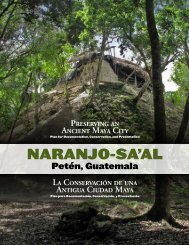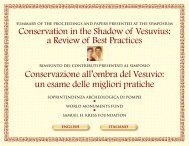Purana Qila and its surroundings (pdf) - World Monuments Fund
Purana Qila and its surroundings (pdf) - World Monuments Fund
Purana Qila and its surroundings (pdf) - World Monuments Fund
Create successful ePaper yourself
Turn your PDF publications into a flip-book with our unique Google optimized e-Paper software.
Baoli<br />
The baoli or stepwell at <strong>Purana</strong><br />
<strong>Qila</strong> lies between the <strong>Qila</strong>e-Kohna<br />
Masjid <strong>and</strong> Sher<br />
M<strong>and</strong>al. It is an interesting<br />
example of medieval water<br />
management. Stepwells like<br />
this one were typically fed<br />
by rainwater, sometimes<br />
supplemented by water<br />
from underground springs.<br />
A series of steps – in this<br />
case, eighty nine – separated<br />
by l<strong>and</strong>ings (this baoli has<br />
eight of them) lead down<br />
to the stepwell, allowing<br />
people to descend to the<br />
baoli to fetch water. Typically<br />
(as you’ll see in this baoli),<br />
the water was covered<br />
over with a roof to reduce<br />
evaporation <strong>and</strong> to keep the baoli clean.<br />
The baoli is made mainly out of Delhi quartzite stone. It’s closed<br />
to visitors, so you can’t go down to the water, but the fence<br />
surrounding the baoli is low enough for you to look over <strong>and</strong> see<br />
most of it. The water’s now stagnant <strong>and</strong> dirty, but the well beyond<br />
– on the north-eastern end of the baoli – is still in use.<br />
Hammam<br />
Like the baoli, the hammam – the bath complex – seems to pale into in<br />
signifi cance in comparison with Sher M<strong>and</strong>al or the <strong>Qila</strong>-e-Kohna<br />
mosque. Also like the baoli, however, the hammam was an important<br />
aspect of life in the citadel.<br />
The hammam lies to the west of Sher M<strong>and</strong>al, at the base of the low<br />
hillock on which Sher M<strong>and</strong>al st<strong>and</strong>s. It is a square, low building<br />
covered all over on the outside with thin Lakhori bricks. There<br />
are no decorative elements – this is obviously a solidly practical<br />
building – but earthenware pipes originally used to carry water<br />
through the hammam can still be seen in places. The interior of the<br />
hammam also includes a chute in one of the walls.<br />
Interestingly enough, the hammam is a relatively new discovery;<br />
it had been built over <strong>and</strong> was unearthed only in 1913 when the<br />
British began clearing <strong>Purana</strong> <strong>Qila</strong> of modern buildings.<br />
purana qila booklet.indd 8 27/09/12 3:38 PM
















